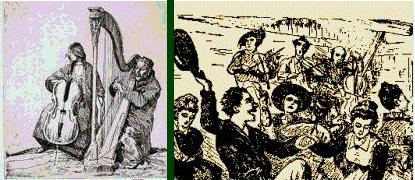Sandro's comment reminds me that some of you learning to read standard notation, with your noses deep into Suzuki, Schroeder, Essential Elements, or your orchestra repertoire, might not know there is another notation method worth knowing. Or, at least knowing of: ABC.
ABC is a method of notating music as plain text. No special fonts, or special software. Any simple text editor will do. Or, for that matter: paper and pencil.
It's not a totally new idea. In the 19th century, the Shakers notated the songs that they composed or received from divine inspiration (about 400 of them) as note letter names, with a method of indicating note length values, dotted rhythms, and the like. ABC is something like that, but with considerably more features.
See John Chamber's ABC Music Notation for a tutorial on ABC.
One of the really good things about ABC is that it makes it easy to share written music over the Internet. And you don't really have to learn ABC to use it. John Chambers has made available to the public computer programs that convert ABC into standard notation or MIDI files.
And there's a whole lot of folk tunes in ABC out there across the Internet universe.
So, Chambers also has a web page that will (1) search for ABC files by name or partial name, or by a sequence of notes, (2) produce a listing of the matches, (3) convert the ABC file to standard notation as a gif, postscript, or pdf, and (4) also convert the file to a MIDI, so you can hear what it sounds like.
It's absolutely great for looking up tunes that you want to learn. See JC's ABC Tune Match at trillian.mit.edu.

Old World or New, Sacred or Profane
Subscribe to:
Post Comments (Atom)
3 comments:
My fiddle group uses ABC a lot, so I have read about it and used it a little, though have not written any music in it.
I have a question you might be able to answer--how does bass clef work in ABC? Is there a way of converting a treble clef piece to bass clef without rewriting it? I'm guessing there is no simple transposition.
I use Coda Finale, so resisted ABC as "primitive," but it is useful with fiddle groups.
There is, by the way, a lot of Scottish fiddle music online at http://www.scottishfiddle.org/bh/
click on "Tunes 03/07" This is the Scottish fiddle camp I went to last summer (with Abby Newton).
C to B (upper case) is middle C up to B in the middle of treble clef. To put it down an octave, follow the note name with a comma. For another octave down, make it two commas. So a 5-octave C scale, starting on cello's lowest C (2 leger lines below bass clef), is:
C,, D,, E,, F,, G,, A,, B,, C, D, E, F, G, A, B, C D E F G A B c d e f g a b c' d' e' f' g' a' b' c''
Wow! I see vistas of opportunity opening before my very eyes! Thanks.
Post a Comment